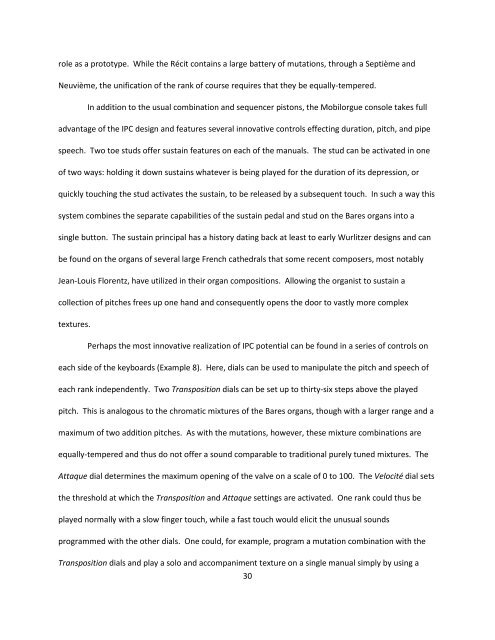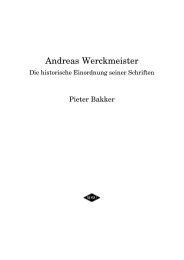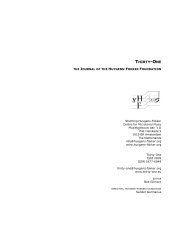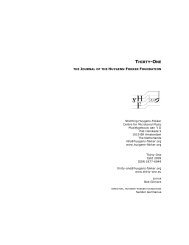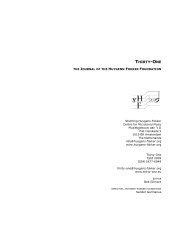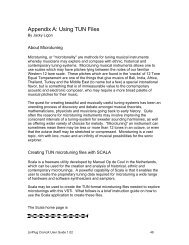Recent Organ Design Innovations and the 21st-century - Stichting ...
Recent Organ Design Innovations and the 21st-century - Stichting ...
Recent Organ Design Innovations and the 21st-century - Stichting ...
You also want an ePaper? Increase the reach of your titles
YUMPU automatically turns print PDFs into web optimized ePapers that Google loves.
ole as a prototype. While <strong>the</strong> Récit contains a large battery of mutations, through a Septième <strong>and</strong><br />
Neuvième, <strong>the</strong> unification of <strong>the</strong> rank of course requires that <strong>the</strong>y be equally-tempered.<br />
In addition to <strong>the</strong> usual combination <strong>and</strong> sequencer pistons, <strong>the</strong> Mobilorgue console takes full<br />
advantage of <strong>the</strong> IPC design <strong>and</strong> features several innovative controls effecting duration, pitch, <strong>and</strong> pipe<br />
speech. Two toe studs offer sustain features on each of <strong>the</strong> manuals. The stud can be activated in one<br />
of two ways: holding it down sustains whatever is being played for <strong>the</strong> duration of its depression, or<br />
quickly touching <strong>the</strong> stud activates <strong>the</strong> sustain, to be released by a subsequent touch. In such a way this<br />
system combines <strong>the</strong> separate capabilities of <strong>the</strong> sustain pedal <strong>and</strong> stud on <strong>the</strong> Bares organs into a<br />
single button. The sustain principal has a history dating back at least to early Wurlitzer designs <strong>and</strong> can<br />
be found on <strong>the</strong> organs of several large French ca<strong>the</strong>drals that some recent composers, most notably<br />
Jean-Louis Florentz, have utilized in <strong>the</strong>ir organ compositions. Allowing <strong>the</strong> organist to sustain a<br />
collection of pitches frees up one h<strong>and</strong> <strong>and</strong> consequently opens <strong>the</strong> door to vastly more complex<br />
textures.<br />
Perhaps <strong>the</strong> most innovative realization of IPC potential can be found in a series of controls on<br />
each side of <strong>the</strong> keyboards (Example 8). Here, dials can be used to manipulate <strong>the</strong> pitch <strong>and</strong> speech of<br />
each rank independently. Two Transposition dials can be set up to thirty-six steps above <strong>the</strong> played<br />
pitch. This is analogous to <strong>the</strong> chromatic mixtures of <strong>the</strong> Bares organs, though with a larger range <strong>and</strong> a<br />
maximum of two addition pitches. As with <strong>the</strong> mutations, however, <strong>the</strong>se mixture combinations are<br />
equally-tempered <strong>and</strong> thus do not offer a sound comparable to traditional purely tuned mixtures. The<br />
Attaque dial determines <strong>the</strong> maximum opening of <strong>the</strong> valve on a scale of 0 to 100. The Velocité dial sets<br />
<strong>the</strong> threshold at which <strong>the</strong> Transposition <strong>and</strong> Attaque settings are activated. One rank could thus be<br />
played normally with a slow finger touch, while a fast touch would elicit <strong>the</strong> unusual sounds<br />
programmed with <strong>the</strong> o<strong>the</strong>r dials. One could, for example, program a mutation combination with <strong>the</strong><br />
Transposition dials <strong>and</strong> play a solo <strong>and</strong> accompaniment texture on a single manual simply by using a<br />
30


